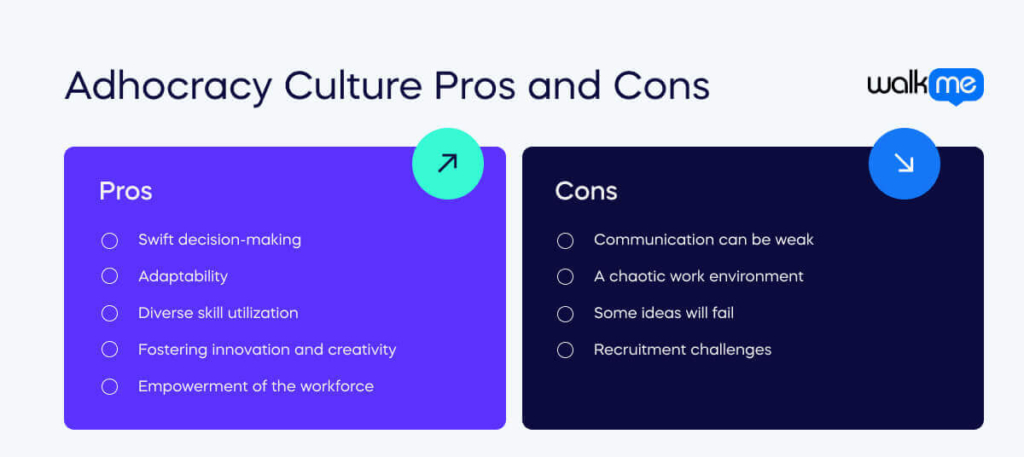Why does your organization function the way it does?
Organizational culture is everything when it comes to ‘the way we do things’ in enterprise settings. But these cultures don’t grow out of nothing. And if a culture isn’t healthy, leaders can positively influence them to transform a stagnant culture into an empowered, productive one.
The four types of culture in any enterprise setting are hierarchy, clan, market, and adhocracy, which we will discuss in this article.
New terms like adhocracy can feel intimidating if you’ve never heard of them. And let’s be honest, words as weird as adhocracy don’t come up often around the office.
So think of it like this. Adhocracy cultures foster an adaptable workspace, prioritizing individual autonomy and innovation.
This structure is different from traditional top-down models. It embraces a fluid leadership approach where employees are encouraged to take charge based on their expertise.
To help you understand adhocracy culture and consider whether it is right for you, let’s explore its key characteristics, advantages and disadvantages, examples, and how to promote this kind of culture via your HR team.
What is adhocracy culture?
An adhocracy culture embodies a corporate ethos that is less traditional.
It represents decentralized leadership, personal initiative, and spontaneous decision-making. It avoids rigid hierarchies and protocols. Instead, it empowers employees closest to the front lines to innovate and resolve challenges while continually adapting strategies.
Therefore, finding the right organizational culture is essential to staff satisfaction. It’s always worth finding the right culture for your organization and employees.
What are the key characteristics of adhocracy culture?

Let’s break it down to help you understand an adhocracy culture. The key characteristics are pro-risk practices, dynamic environments, an organic team structure, and agile approaches. Let’s begin with the adhocracy approach to risk and why this works best for this culture.
Pro-risk practices
Adhocracy fosters innovation and embracing risk. It promotes a culture that encourages questioning conventions. This approach enables staff to venture into uncharted territory.
The outcome when employees unleash their creativity is the development of fresh approaches, products, and services.
This dynamic environment perpetuates a cycle of ongoing enhancement and growth. It drives organizational adaptability and competitive advantage in rapidly evolving market landscapes.
A dynamic environment
A dynamic environment in an adhocracy culture facilitates constant innovation. It also promotes risk-taking. It does this by encouraging employees to question norms and explore new avenues.
This environment fosters creativity and the emergence of novel methods, products, and services.
Such an environment is crucial for adhocracy. It enables continuous improvement, organizational adaptability, and competitive advantage. It does all this in rapidly evolving market landscapes.
Organic team structure
An organic team structure in adhocracy fosters flexibility and collaboration. It enables individuals to contribute based on expertise rather than rigid hierarchies.
This team structure promotes innovation. It facilitates quick decision-making and adaptability to changing circumstances.
It is vital for adhocracy as it encourages decentralized authority. It empowers employees to take initiative, and cultivates a culture of autonomy and creativity. These qualities are essential for continuous improvement and organizational growth.
Agile approaches
Flexibility is not just a value but a practiced skill within adhocracies. Teams receive training to swiftly pivot in response to evolving business landscapes, forming specialized groups to tackle emerging challenges head-on. This adaptive mindset ensures readiness for whatever the dynamic market may present.
These characteristics are a great place to start if you seek an adhocracy culture. Do they already align with how your organization operates, or are they completely different from how you do things? Consider these cultural features to decide if this culture would benefit your organization.

What are the advantages of adhocracy culture?
Certain companies find an adhocracy culture more attractive than traditional organizational models. This point is especially true in industries characterized by unpredictability and rapid technological advancements, like design and manufacturing. This culture can also manifest on a smaller scale within specific business units.
Adhocracy culture offers several advantages:
Swift decision-making
Adhocracy culture prioritizes quick decision-making. This approach allows organizations to respond promptly to market shifts and opportunities.
They can capitalize on time-sensitive situations by minimizing bureaucratic challenges. They can also empower teams, maintain agility, and gain a competitive edge.
This agility ensures that organizations can swiftly align their strategies with evolving market dynamics. Doing so enables them to stay ahead of the curve and effectively navigate uncertainties.
Adaptability
Adhocracy culture thrives on adaptability. This adaptability enables organizations to respond to changing circumstances.
By embracing flexibility and open-mindedness, adhocracies can pivot their strategies. They can also pivot processes and structures. This approach allows them to align with emerging trends and evolving customer needs.
It also ensures that organizations remain resilient to disruptions, seize new opportunities, and sustain long-term success in dynamic environments.
Diverse skill utilization
Adhocracy culture values the diverse skill sets and perspectives of its workforce.
Adhocracies can tackle complex challenges with innovative solutions. They do so by promoting cross-functional collaboration. They also leverage the strengths of individuals from different backgrounds.
Utilizing diverse skills fosters creativity, enhances problem-solving capabilities. It also enables organizations to address multifaceted issues comprehensively. This approach leads to more robust and effective outcomes.
Fostering innovation and creativity
Adhocracy culture nurtures a fertile environment for innovation and creativity to flourish. Organizations can spark new ideas, approaches, and solutions. They do so by encouraging experimentation, risk-taking, and unconventional thinking.
This culture of innovation enables adhocracies to stay ahead of competitors. It drives continuous improvement, and pioneers groundbreaking products, services, and processes.
Fostering innovation and creativity is essential for adhocracy culture to remain dynamic, relevant, and resilient in rapidly evolving markets.
Empowerment of the workforce
Adhocracy culture empowers employees. It does so by decentralizing decision-making authority. It also promotes autonomy and accountability.
Organizations should entrust teams with the freedom to make decisions and take ownership of their work. They can then unleash the full potential of their workforce.
This empowerment fosters a sense of ownership, commitment, and motivation. leading to higher engagement, productivity, and job satisfaction.
Empowering the workforce is crucial for adhocracy culture to foster a culture of trust, collaboration, and continuous learning, driving organizational success and resilience.
What are the disadvantages of adhocracy culture?
Adhocracy culture doesn’t suit every type of business. The lack of designed processes and prescribed procedures won’t work for industries requiring strict protocols. It’s important to consider if this approach might limit your organization.
Here’s a breakdown of some of the drawbacks and limitations:
Communication can be weak
There can be confusion because there is little structure on how individuals complete tasks and much emphasis on individual initiatives. Employees may not fully understand where to get and direct important information or know who handles certain situations.
Adhocracies need to find effective communication methods. Otherwise, it leads to people missing things, duplicating work, and delays.
A chaotic work environment
Unpredictability may kindle creativity, but people sometimes feel lost in a constantly changing setting.
Without a set leadership chain, employees might not fully understand all their responsibilities or how well they’re performing. It can also be unclear who to go to for guidance on duties or interpersonal conflicts.
Not everyone works at their highest level without structure. A more laid-back attitude about processes and work hours can impact timelines and quality control.
Some ideas will fail
Risk-taking doesn’t always lead to success. Failures are normal, so an organization must be able to tolerate them. Spontaneous decision-making that omits market research or risk management can waste money on something that doesn’t pan out.
A lack of planning for possible problems puts you in a reactionary mode. On the other hand, having mitigation measures or solutions prepares you for issues that may arise.
Recruitment challenges
An adhocracy is not the right environment for everyone. People who crave stability, procedures, and routine are not strong candidates, which can narrow down your recruitment options.
Also, it is a setting more suitable for experienced individuals rather than people at the beginning of their careers.
Fast-paced conditions demand employees with honed techniques who don’t need much supervision. Leaders need to have a great deal of confidence that their team members can handle whatever comes at them.
Adhocracy culture examples
The best way to understand adhocracy culture is to look at examples of enterprises that have implemented it successfully. It is also essential to consider what we can learn from each example.
We include a ‘what we can learn’ section below each example. The first example involves gaming giant Valve.
Valve
Valve, the gaming platform, and developer, champions a decentralized model devoid of traditional managerial hierarchies. Here, employees autonomously initiate projects and form teams based on their interests.
Decision-making receives equal distribution, enabling agility and adaptability to market dynamics. This approach fosters a culture of innovation, as employees have the freedom to pursue projects they’re passionate about.
By rejecting rigid structures, Valve maximizes creativity, collaboration, and responsiveness to emerging opportunities, positioning itself as a pioneer in the dynamic gaming industry.
What can we learn from this example?
Coordinating activities around opportunities is the hallmark of different organizational paradigms. While bureaucracies rely on rules and procedures, and meritocracies pivot around information flows, adhocracies thrive on discrete opportunities.
Mundipharma
A key characteristic of adhocracy is the fluidity of project teams. Mundipharma, an emerging pharmaceutical force, exemplifies this principle by structuring business units around individual drug prospects.
Should a unit encounter difficulties in launching a drug, it dissolves, allowing personnel to transition to more promising endeavors.
This adaptive approach ensures swift resource reallocation, maximizing the organization’s agility and responsiveness to evolving market conditions.
What can we learn from this example?
This market-centric model mirrors the agility of venture capitalism, investing only in ventures with clear commercial viability.
Adhocracy’s knack for aligning workers with external opportunities fosters agility and decisiveness, outperforming the ponderous processes of bureaucracies and meritocracies.
Costa Coffee
Making decisions through experimentation is another cornerstone of adhocracy. While bureaucracies rely on hierarchical directives and meritocracies on debate, adhocracies favor experimentation. Costa Coffee’s Project Marlow exemplifies this approach.
In 2012, the company rapidly transformed its vending machine offerings, successfully launching a new self-serve system within months. Decisions were swift, based on what propelled the project forward, rather than bureaucratic formalities.
Project leader Eric Achtmann championed rapid decision-making and a results-oriented mindset, epitomizing adhocracy’s ethos of agility.
What can we learn from this example?
Intuition plays a pivotal role in an adhocracy’s decision-making process. Unlike meritocracies, which take a data-driven approach, or bureaucracies, which follow top-down directives, adhocracies rely on instinct honed through immersion in project dynamics.
Agile methodologies, like those embraced in software development, epitomize this ethos.
Adhocracy thrives on agility, experimentation, and a culture of achievement. Align activities around opportunities, embracing rapid experimentation, and motivating through challenges.
Doing so allows your adhocracies to outshine their bureaucratic counterparts in today’s dynamic business landscape, as seen in the successful enterprise examples above.
How can your HR team promote an adhocracy culture?
Now that you understand adhocracy culture and its advantages and disadvantages, it’s time to consider how your HR team can promote it. The first step is to foster a culture of creativity.
Foster a culture of creativity
Foster a culture of creativity by instilling a mindset that encourages employees to think beyond conventional boundaries.
Cultivate an environment where employees receive praise for risk-taking, empowering individuals to explore innovative solutions.
Develop a flexible organizational structure
Developing a flexible organizational structure is paramount in aligning with adhocracy’s ethos of adaptability. Implementing a flat hierarchy fosters collaboration and allows for seamless cross-functional teamwork.
This structure promotes agility, enabling swift responses to changing market dynamics and fostering a culture where creativity thrives.
Emphasize autonomy and empowerment
Emphasizing autonomy and empowerment is essential in nurturing an adhocracy culture. Providing employees with the autonomy to make decisions fosters a sense of ownership and accountability.
Encouraging initiative and offering ample support empowers individuals to drive projects forward independently, fostering a culture of self-reliance and innovation.
Encourage experimentation
Encouraging experimentation is a cornerstone of adhocracy culture. Encourage employees to explore new approaches. Encourage them to push boundaries by promoting a mindset that embraces trial and error.
Celebrating successes and failures as valuable learning experiences fosters a culture of resilience and continuous improvement.
Focus on continuous improvement
Focusing on continuous improvement underscores the commitment to innovation inherent in adhocracy culture. Encouraging employees to stay abreast of industry trends and best practices ensures a culture of ongoing learning and development.
Providing professional growth and training opportunities empowers individuals to continuously enhance their skills, driving innovation and propelling the organization forward.
Remember that adhocracy doesn’t work for every organization
The advantages of an adhocracy culture, like an empowered workforce that strives for creativity and innovation with a diverse skill set and swift decisions, can look attractive.
However, it’s essential to consider whether a radical new culture is right for your organization before committing.
First, ask yourself if adhocracy culture aligns with your organizational values.
Second, consider how this new culture would impact employee experience. If the impact is negative, the culture is unsuitable for your employees or your organization.
Finally, consider your company’s readiness for change. Creating organizational readiness for change can be challenging, but the rewards can be significant if you need a new culture.
Whether an adhocracy culture is right for you can save you time, money, and staff frustration. It allows you to spend resources on growth for a brighter future and a healthier culture.


